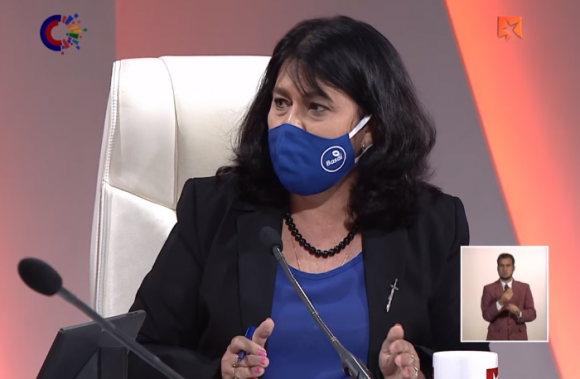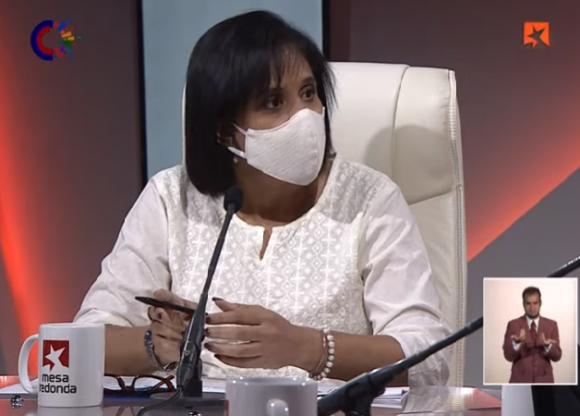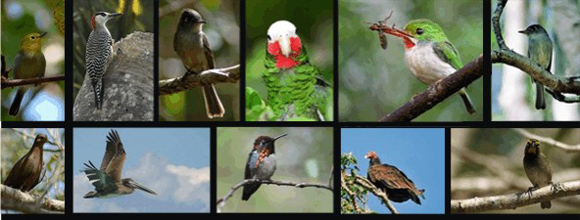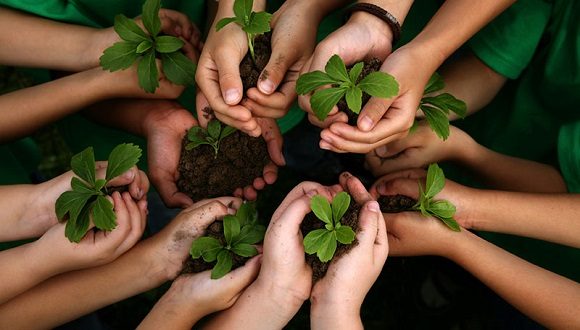
How is the State Plan to face climate change, known as the Life Task, working? What main actions are taking place in 2021? Authorities from the Ministry of Science, Technology and Environment (Citma) responded to these questions on Wednesday at the Round Table.
Environmental Policy: Priority of the Cuban State
Dr. Adianez Taboada Zamora, vice president of Citma, began her intervention at the Roundtable, referring to the challenges Cuba faces in environmental matters and how policies in this area are managed to achieve the sustainable development of the country.
He detailed the complicated international context in which Cuba faces the challenge of developing environmentally: “Every year more than 4.7 million hectares of forests are lost, global greenhouse gas emissions have increased consecutively in the last three years and almost 89% of the world's wastewater is discharged untreated into our oceans. "
In addition, she mentioned the impact of drought and increased temperatures, which cause species substitutions, greater aridity, fire risks and lower soil fertility and water availability.
"These issues confirm the need for all countries to take measures and draw up strategies that allow to halt deterioration and reverse the current situation with ecosystems, therefore, also to seek adaptation and mitigation measures to the effects of climate change. ", He said.
He recalled that to counteract these problems, international agreements have been established to which Cuba has been a signatory, such as the United Nations Framework Convention on Climate Change, the Kyoto Protocol, the Paris Agreement and the Conventions on Biological Diversity and the Fight against Climate Change. desertification and drought.

He stressed that nations have common needs, but differentiated. "Cuba registers 0.1% of greenhouse gas emissions, while the United States registers 20%."
Likewise, he highlighted the strong political will of the Cuban Government to address environmental issues, based on what is defined in Article 75 of the Constitution of the Republic: “It speaks of the rights of all citizens to enjoy a healthy environment and balanced and, at the same time, its relationship with the sustainable, economic and social development of the country ”.
He also explained that one of the axes of the Cuban plan for economic and social development until 2030 is that of natural resources and the environment.
According to the vice president of Citma, among the government's working mechanisms to follow up on the environmental plan are macroprograms. "There is one specifically that contains two programs: the national environmental strategy, with several projects, and the confrontation with climate change and early warning systems."
Currently the country's environmental system is being perfected and contextualized. “We have an Environmental Law and it is necessary to highlight that in Cuba there have been changes from the Constitution itself with the entire legislative system (territorial development, new forms of management) to the results of science and the State Plan to confront climate change : the Life Task ”.
Taboada Zamora specified that the Cuban environmental system is not only the responsibility of Citma, but also that it has a country system.
He clarified that the Citma has the mission of proposing policies, controlling that they are implemented and methodologically accompanying them, but that in reality the entire population participates in the important task and, in a very particular way, research centers, universities and civil society (Botanical Society, the Zoological Society and the Antonio Núñez Jiménez Foundation), in addition to the rest of the entities that want to join, depending on the implementation of these policies ”.
What is the Cuban environmental strategy?

Odalys C. Goicochea Cardoso, Citma General Director of the Environment, explained at the Round Table the Cuban environmental strategy, its main elements, strategic frameworks, the challenges it responds to and the role of the Life Task within it.
"To understand the mechanism that we have designed, we must start from the concept of an environmental problem, understood as the adverse conditions that the human being himself has been creating."
She highlighted the role of Citma in ensuring environmental sustainability in the economic and social development of the country. "This is done in conjunction with the agencies of the Central State Administration, which manage natural resources and have an impact on our ecosystems, environmental quality and the way in which we face climate change."
Since 1997, Cuba has an environmental strategy, defined in Law 81 of the Environment itself as the base instrument for the implementation of Cuban policy and based on criteria such as the impact of the environment on the quality of life, people's health, ecosystems ..
She assured that science has been very important to get to have environmental programs, to be able to implement them and, finally, to develop actions that counteract the adverse effects of environmental problems.
"This strategy is based on a deep diagnosis of the state of the country's environment, based on the results of research on ecosystems, and as explained, all the scientific potential of many agencies of the Central State Administration is involved," he said. ”, Goicochea Cardoso.
According to the specialist, the Citma gives coherence to the environmental policy, agrees with all those involved in the Cuban environmental system and defines the existing problems.
Today, Cuba must continue to insist on solving environmental difficulties that began in 1997, such as the effects on forest cover; problems in water quality due to the effects of pollution; pollution itself and soil degradation, according to experts the main problem affecting the country's food security.
The Citma General Director of the Environment commented that from the 2007-2010 cycle, the impact of climate change began to be seen as an environmental problem. "I must clarify that all these effects are different in their theoretical approach, but they have a close link."
Regarding the framework of the strategy, Goicochea Cardoso said that it is essentially based on the Life Task, through its five strategic actions and 11 points. "Its priority is the issues of adaptation, so Cuba has determined that in the coastal ecosystems where a large part of the population resides, their restoration should begin, so that they recover their values and initial conditions and can serve as a protective shield to extreme weather events ”.
She updated that the Life Task started in April 2017 has already closed its short term. “We are satisfied, we have advanced in a very complicated context. An example of this is point eleven directed at international financing to face environmental problems.
“In the board of the Green Climax Fund, this task was not approved by the US, but by majority it was certified and is what is known as the Mi Costa project, whose objective is to achieve solid financing so that damaged coastal areas can be start doing a group of actions ”.
For the 2021-2025 cycle, Citma will work in three directions: restoring ecosystems, that infrastructures have levels of reconversion, in order to improve technology and preserve natural resources.
To measure the effectiveness of this strategy, the ecological footprint, climate resilience and environmental quality will be used as indicators, the latter more linked to pollution issues.
At the end, he highlighted the work carried out from the base, in the municipalities. “There are our natural resources and it is where the ecosystems are connected. For this reason, research and innovations must start from there, and the most important thing has been the knowledge and awareness of our population around these issues ”.
How are illegalities against natural resources fought?
Jorge Álvarez Álvarez, director of the Office of Regulation and Environmental Safety (ORSA), recalled that last year Decree-Law No. 10 was approved for the creation in the country of the National Regulatory Authorities, and among its functions is the authorization and control of the fulfillment of the legislations.
This rule, he said, raises the rank of those authorities, which are no longer subordinate to the agencies but attached, as well as approved by the Council of Ministers.
According to Álvarez, the ORSA works with two approaches, one related to the problems existing in the country before the approval of environmental legislation, which are not exclusive to Cuba, and the other related to what arose after the entry into force of this regulatory package.
There are certain situations that do not have to be tolerated and one of them, commented the director of the Office of Regulation and Environmental Safety, are illegalities against natural resources such as water, soil, forest, mineral resources and biodiversity.
A demonstration of the government's will to counteract these behaviors, last year a green light was given to a plan to confront these illegalities. Álvarez mentioned that the systemic nature of the state environmental inspection, which appears in the Environment Law, has been implemented.
Regarding the environment, and specifically natural resources, the institutional framework is diverse: ministries of Agriculture, Food Industry, Hydraulic Resources, Energy and Mines, among others.
The manager pointed out that with the systemic nature of the state environmental inspection, a concerted and coordinated action is sought among all the actors involved. "Before we (representatives of the Office) went to a river where waste was being dumped, but we had no power to proceed in that case."
In the midst of the pandemic, he commented, inspections have been carried out in protected areas that have had this new character.

Regarding the biodiversity of flora and fauna species, he denounced that there is currently a very complicated situation with illegal trade, while recalling that Cuba has had a list of legally protected species since 2011, which "came out of science and knowledge".
"These species are being commercialized, both through social networks and in physical spaces," he pointed out.
The director of the Office of Regulation and Environmental Safety assured that they are working in a coordinated manner to act and said that since the approval of the government plan, the fines imposed by the forest rangers have increased, with processes that have gone through criminal proceedings.
These efforts, he expanded, must be seen in their relationship with the new Animal Welfare Law, as well as with the approach promoted by the United Nations of “one health”. "Human beings are getting closer to animals and their health depends on theirs and on that of the ecosystem."
Another issue that is still latent are violations, said the manager and specified that with the approval of the standard on animal welfare the fines increased to around 1,500 CUP, but “when you enter the pages of foreign sites a Cuban songbird is quoted to 200 or 300 dollars. Even a parrot can be priced at 500 euros. Really the cost-benefit is to pay the fines and continue in the illegal trade ”.
These people, he lamented, have no idea of the environmental damage they cause and the role of these species in the ecosystem. “When a legal trade is authorized, it also involves science and it is said when it can be captured, how many, of what sex and size. When it is done illegally, in the case of birds, males are often preferred (because they are more showy) ”.
“There are species of fish known as parrot, whose function is to protect the reef, consuming the algae. However, illegal fishing is killing these fish. "
The director of the Office of Regulation and Environmental Safety summarized that it is a complex issue, which he is facing with all the rigor he demands.
“Manglar Vivo” and other initiatives to restore the mangrove ecosystem
The “Manglar Vivo” project began to be implemented in Cuba in 2014 and last year its execution concluded satisfactorily, but it maintains the will to continue work on other initiatives in search of restoring the mangrove ecosystem, with its forests and wetlands, he said. at the Round Table José M. Guzmán Menéndez, technical director of the project.
The problems related to mangroves are very complex, because they not only depend on trees but also on water. “Managing these wetlands is putting all the actors at the table with their responsibilities. We have a forest that belongs to the forestry company and is cared for by the forest rangers, where Hydraulic Resources have interventions and opportunities ”.
Guzmán Menéndez commented that the project was developed on the southern coast of the Artemisa and Mayabeque provinces, sponsored by the United Nations Development Program (UNDP) and with the support of Citma and the Ministry of Agriculture.
Thanks to the work done, he said, there is already the first manual to restore the health of the mangroves, which was not only applied in Artemisa and Mayabeque, but in other places with different conditions such as Havana Bay and Caimanera.
The technical director of the “Manglar Vivo” project explained that Cuba, as an archipelago, has a wide exposure to the coastal zone, almost 70% occupied by mangroves, with incredible dynamics, but that depend a lot on the actions of the man.
He regretted that although mangroves can withstand the impact of extreme events such as cyclones, the problem arises when we do not give them all the water and other resources to recover, leading to their weakening.
The protection of onshore agricultural resources is also decisive, argued Guzmán Menéndez and referred to other results of the project such as the valuation of goods and services of the mangrove ecosystem and the Ciénaga forest.
There is already, he added, how much it costs to restore the mangrove ecosystem in a period of five years, which is important for the economic planning of the municipalities.
For the preparation of the manual, he explained, the criteria and knowledge of those who have worked in the territories empirically were taken into account. The implementation of this procedure proved its worth, not only for Cuba but for the Caribbean.
He made reference to the realization of a publication where the impact of the mangroves for the recruitment of the region and the adaptation to climate change was demonstrated.
“Mangroves are tidal forests and they will colonize them depending on how they rise. The problem is our ways of life, economic settlements, the culture of the coastal area. This is what Manglar Vivo left, that people see this project as an opportunity to live much better in the face of the negative events of climate change from coastal resilience ”.
World Environment Day: "Reimagine your environment"

Next June 5, World Environment Day will be celebrated, a new day to which Cuba will arrive with achievements and challenges, said Adianez Taboada Zamora, vice minister of Citma.
Among the challenges facing 2030, he mentioned the commitment that 24% of energy generation be from renewable sources, the introduction of electric vehicles, increasing wooded covers by up to 33%, as well as introducing much more biogas in the pig sector.
She commented that the day for World Environment Day is being dedicated to the restoration of ecosystems and the global motto is "reimagine, recreate and restore." In the case of Cuba, the call is called "reimagine your environment" and several activities will be carried out, including the planting of trees throughout the country.
"The most important thing is that the people accompany us, first to plant and then to make the trees grow," she said.
Likewise, he added, the successful experiences of ecosystem restoration will be disclosed and recognized, such as the one carried out on the southern coast of Artemisa and Mayabeque, on the sandy beaches of tourist interest poles and the rehabilitation of mined areas in the north of the province. of Holguín.
CUBADEBATE
